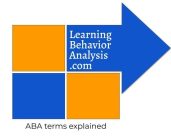B-15: Define and provide examples of derived stimulus relations ©
Want this as a downloadable PDF? Click here!
Target Term: Derived Stimulus Relations
Derived Stimulus Relations
Definition: A relation between two or more stimuli that is not directly trained and not based on physical properties of the stimuli. If A, B, and C all correspond to the same thing, and only A-B and B-C are directly trained, the relation drawn between A and C is derived.
Example in everyday context: A person is taught that the spoken word “dog” (stimulus A) corresponds to an actual physical animal (stimulus B). The person also learns that the animal (stimulus B) corresponds to the word “chien” in French (stimulus C). The relationship between “dog” and “chien” was never directly taught; it was derived.
Example in clinical context: A client is taught to read, and makes connections between the written word TRUCK and a real physical truck without having been directly taught this connection. Relations were derived between A and C through the following learning: written word (A) = spoken word (B) and spoken word (B) = physical object (C).
Why it matters: Derived stimulus relations can be used to teach complex verbal behavior as well as treat emotional and behavior problems.
